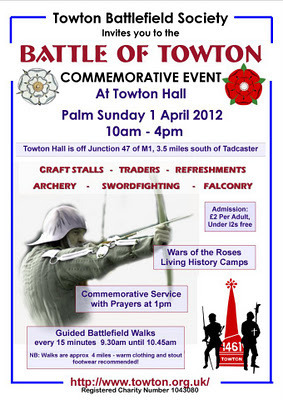S.M. Harrison's Blog, page 2
March 25, 2013
Keeping Up Appearances
There are many books, blogs and websites that offer writers advice when it comes to writing character descriptions: 'show don't tell'; 'less is more'; 'make the description tell us more about the character than just their physical appearance' etc. etc. Of course, by definition if you are writing fiction then the character exists clearly in your head and it is your job to communicate that to the reader, so that if they were asked to describe the character at the end of the novel they would come up with your character just as you imagined them. Writers of historical fiction often have a different problem they have to figure out for themselves in that the person they are writing about actually existed but there are either no contemporary likenesses of them or worse still there are sketchy ones available or vague descriptions (both on appearance and character) by contemporary writers which we may wish to believe or disbelieve depending on their relationship to the said character! The former does allow the writer more of a free rein to develop the character as their own, whereas the latter offers up a number of difficult choices.
One of my main protagonists in both 'The Colour of Treason' and 'A Rose of England' is Richard Neville, Earl of Warwick (you may know him as The Kingmaker) and unfortunately for me there are a few contemporary likenesses to pick and choose from:
1. Probably the closest to life as he was involved in commissioning it in the 1450s: his depiction as a weeper on Richard Beauchamp's tomb in St Mary's Warwick. (Beauchamp was Warwick's father-in-law). This shows Warwick, perhaps symbolically, as an older man however, as he was only 42 when he died at the Battle of Barnet in 1471.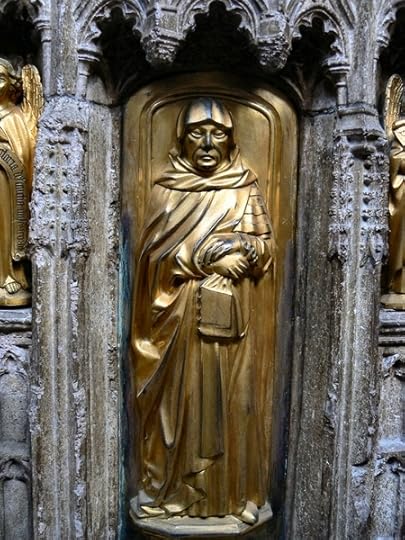
There is a general family likeness in the mourners which is also apparent in the earlier 'Neville family at prayer' depicting Warwick's father and his siblings from the Neville Book of Hours c1430:
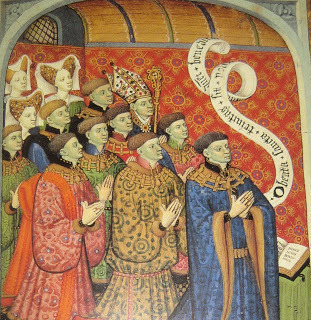
2. Salisbury Roll of Arms - completed around 1463 to mark the re-internment of his father at Bisham Abbey. Highly stylised and probably not a true likeness.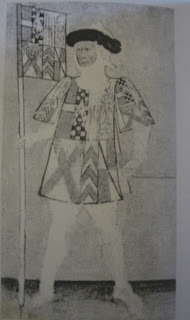 3. So-called Rous Roll compiled 1483-85 during the reign of Richard III and probably by Warwick's widow, the Countess of Warwick - again highly stylised and probably no attempt at a likeness.
3. So-called Rous Roll compiled 1483-85 during the reign of Richard III and probably by Warwick's widow, the Countess of Warwick - again highly stylised and probably no attempt at a likeness.
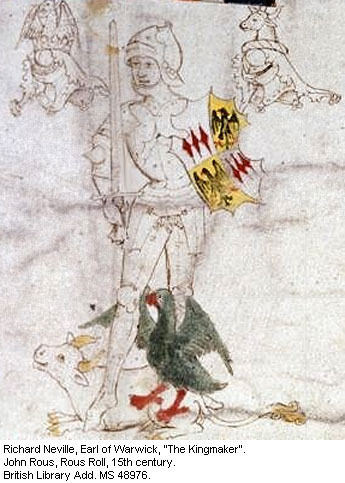 4. The last page in the so-called Beauchamp Pageant almost certainly commissioned by the Countess of Warwick - some attempt at a likeness here as all the figures have different faces. (He is top left as we look at it, pointing towards his countess).
4. The last page in the so-called Beauchamp Pageant almost certainly commissioned by the Countess of Warwick - some attempt at a likeness here as all the figures have different faces. (He is top left as we look at it, pointing towards his countess). 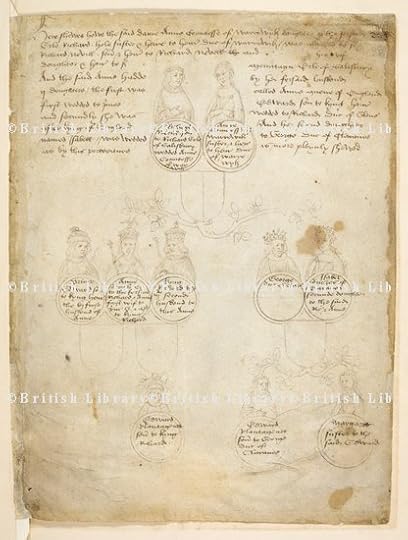 This is painted on the wall at Warwick Castle and Richard Neville has dark brown wavy shoulder length hair and dark eyes:
This is painted on the wall at Warwick Castle and Richard Neville has dark brown wavy shoulder length hair and dark eyes:

And I have gone along with that colouring.
5.His death at the Battle of Barnet in the Besancon version of the Short Arrivall - painted some 10 years after the battle. He is fully armoured but appears quite tall. (Warwick is riding to the right on the white horse with a shield on his back).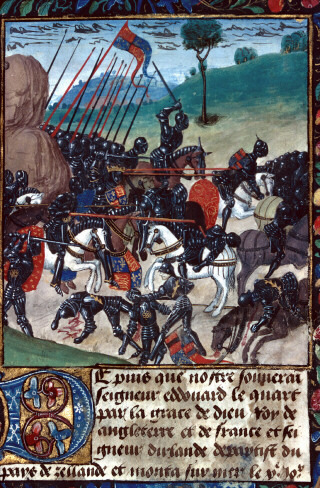 By the manner of dress and hairstyle this image from the Founder's and Benefactor's book of Tewkesbury Abbey is likely to be mid-sixteenth century and therefore not a true likeness:
By the manner of dress and hairstyle this image from the Founder's and Benefactor's book of Tewkesbury Abbey is likely to be mid-sixteenth century and therefore not a true likeness:
In addition the Neville family were generally regarded by contemporaries as being both handsome and tall and as a novelist that was one piece of information I certainly couldn't ignore!
One of my main protagonists in both 'The Colour of Treason' and 'A Rose of England' is Richard Neville, Earl of Warwick (you may know him as The Kingmaker) and unfortunately for me there are a few contemporary likenesses to pick and choose from:
1. Probably the closest to life as he was involved in commissioning it in the 1450s: his depiction as a weeper on Richard Beauchamp's tomb in St Mary's Warwick. (Beauchamp was Warwick's father-in-law). This shows Warwick, perhaps symbolically, as an older man however, as he was only 42 when he died at the Battle of Barnet in 1471.

There is a general family likeness in the mourners which is also apparent in the earlier 'Neville family at prayer' depicting Warwick's father and his siblings from the Neville Book of Hours c1430:

2. Salisbury Roll of Arms - completed around 1463 to mark the re-internment of his father at Bisham Abbey. Highly stylised and probably not a true likeness.
 3. So-called Rous Roll compiled 1483-85 during the reign of Richard III and probably by Warwick's widow, the Countess of Warwick - again highly stylised and probably no attempt at a likeness.
3. So-called Rous Roll compiled 1483-85 during the reign of Richard III and probably by Warwick's widow, the Countess of Warwick - again highly stylised and probably no attempt at a likeness.
 4. The last page in the so-called Beauchamp Pageant almost certainly commissioned by the Countess of Warwick - some attempt at a likeness here as all the figures have different faces. (He is top left as we look at it, pointing towards his countess).
4. The last page in the so-called Beauchamp Pageant almost certainly commissioned by the Countess of Warwick - some attempt at a likeness here as all the figures have different faces. (He is top left as we look at it, pointing towards his countess).  This is painted on the wall at Warwick Castle and Richard Neville has dark brown wavy shoulder length hair and dark eyes:
This is painted on the wall at Warwick Castle and Richard Neville has dark brown wavy shoulder length hair and dark eyes:

And I have gone along with that colouring.
5.His death at the Battle of Barnet in the Besancon version of the Short Arrivall - painted some 10 years after the battle. He is fully armoured but appears quite tall. (Warwick is riding to the right on the white horse with a shield on his back).
 By the manner of dress and hairstyle this image from the Founder's and Benefactor's book of Tewkesbury Abbey is likely to be mid-sixteenth century and therefore not a true likeness:
By the manner of dress and hairstyle this image from the Founder's and Benefactor's book of Tewkesbury Abbey is likely to be mid-sixteenth century and therefore not a true likeness:In addition the Neville family were generally regarded by contemporaries as being both handsome and tall and as a novelist that was one piece of information I certainly couldn't ignore!
Published on March 25, 2013 12:44
March 23, 2013
A Rose of England - Palm Sunday 2013
As you all may know by now, the annual pilgrimage that is the Palm Sunday Battle of Towton Memorial event has had to be cancelled this year due to the poor weather. This was going to be a book launch day for a number of authors, myself included, so instead I'm posting the trailer for the new novel. Hope you like it!
Published on March 23, 2013 14:18
February 3, 2013
Tomorrow's the BIG day
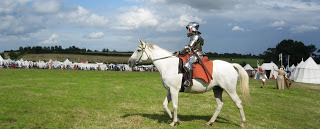
I can't think of a precedent for what's going to happen tomorrow. Tomorrow we shall learn whether the male remains found at the former Greyfriar's Priory site in Leicester are those of the late King Richard III. For all those interested in the Wars of the Roses and for those with an interest in King Richard in particular it is an understatement to say it's going to be an interesting day! Regardless of whether the remains are those of this controversial king, it's a great day for archaeology, highlighting the use of modern methods and techniques not only for identification purposes, but also for the reconstruction of the facial features of the deceased. Although the techniques are now much improved I can remember being excited about a BBC television series which began in 1998 presented by Julian Richards, which sought to 'Meet the Ancestors' using facial reconstruction and I notice the Leicester team are employing the services of Dr Caroline Wilkinson a CRFP registered facial anthropologist/forensic artist who worked on the series in their reconstruction of 'Richard'. I was always fascinated by her work of 'bringing the dead to life' and as a writer of Historical Fiction set in the Wars of the Roses this time I am doubly so!
My current WIP is set in 1470, and Richard features only slightly, in a supporting role to his brother Edward IV as he is exiled and then tries to reclaim his crown from the Earl of Warwick acting for Henry VI, but Richard will feature much more strongly in the follow-up to that and to have one of Caroline's reconstructions would be awesome! Not only will we know what his face was like we should also learn more about any illnesses he may have had as well as his build and stature and more insight into how he died at Bosworth and whether any injuries were inflicted post mortem as was reported in the chronicles of the time. All wonderful stuff for an author about to start a novel covering those events and featuring the 'much-maligned king'!
Published on February 03, 2013 06:37
January 25, 2013
Excited
I am hard at work editing the WIP - the sequel to The Colour of Treason - and as I am quite a while behind schedule due to things beyond my control, let's just say I'm finding it harder than it should be to finish! But I am now a little more enthusiastic as I have had two 5* reviews - one on Amazon and one on Goodreads! Thank you guys - you have really fired me up to finish the next book! Hopefully done and dusted in time for the annual Palm Sunday memorial event at Towton!
Published on January 25, 2013 08:27
January 7, 2013
The Next Big Thing Blog Hop
The Next Big Thing Blog Hop is a chance for authors around the world to tell you what they’re working on. The author answers 10 questions about their next book, and tags the person who first tagged them. My thanks to Karen Clark, a fellow Neville adherent, for tagging me.
What is the working title of your book?
A Rose of England; apt because the central character is a woman who we find in France and Bruges in this novel, so literally a rose of England, but a rose also because it is set in the Wars of the Roses.
Where did the idea come from for the book?
This book is the sequel to The Colour of Treason and they were always conceived together; the original inspiration was the Middleham Jewel, a fifteenth century reliquary in the Yorkshire Museum in York. As I began to read more about it and the people who could have been connected to it, the story began to form in my mind.
What genre does your book fall under?
Historical fiction, but both from male and female points of view.
Which actors would you choose to play the part of your characters in a movie rendition?
I haven’t a person in mind for Elizabeth Hardacre, but I always imagined her as Alexa Wilding, a model for the pre-Raphaelite Dante Gabriel Rossetti such as she is in 'Sibylla Palmifera'. James Purefoy would be Richard Neville, the Earl of Warwick; a young Mark Ryan or possibly Aidan Turner would be Jack de Laverton. A young Heath Ledger would be Thomas Conyers and Tom Georgeson would play Higgins.
What is the one sentence synopsis of your book?
After love and betrayal can there be forgiveness?
Will your book be self-published or represented by an agency?
For personal reasons I had to self-publish The Colour of Treason and I did so as both a paperback and ebook. Even though it was a lot of work, I will probably do the same for 'A Rose of England'.
How long did it take you to write the first draft of the manuscript?
Difficult to say as the two books are so entwined, but from the initial writing to now has taken seven and a half years. I also research as I write; I lay out a basic timeline with major events on it first and use that as a structural template, but I am flexible and if I come across something interesting then it can take the characters in a new direction.
What other books would you compare the story to in your genre?
In scale it is perhaps similar to Sharon K Penman’s 'Sunne in Splendour', but not in style. It is more like Elizabeth Chadwick meets Bernard Cornwell as I write from both male and female points of view and I do love a good battle-scene!
Who or what inspired you to write this book?
As I said earlier the Middleham Jewel was the initial spark, but once I began to read about Richard Neville, Earl of Warwick it took on a life of its own! There was simply nothing this man couldn’t do and his energy and endeavour were inspirational!
What else about the book might pique the reader’s interest?
There are a lot of novels about the Wars of the Roses but most of them paint Warwick as a one-dimensional bad guy which is quite simply not true. This book tries to see things from his point of view and to understand why he made the choices he did. He wasn’t stupid and he wasn’t evil personified and as Elizabeth will show us, he took the path he did because he could see no other way to maintain his family’s powerful position, something he felt he had to do because of the Warwick legend he married into and something he believed he was owed by a king who without Warwick’s enterprise would not have been king at all.
For previews and further information please visit my website: www.smharrisonwriter.com.
I am pleased to tag Helen Cox, author of 'The Lay of Angor' as Rae Andrew and author of several excellent non-fiction books on the Wars of the Roses.
What is the working title of your book?
A Rose of England; apt because the central character is a woman who we find in France and Bruges in this novel, so literally a rose of England, but a rose also because it is set in the Wars of the Roses.
Where did the idea come from for the book?
This book is the sequel to The Colour of Treason and they were always conceived together; the original inspiration was the Middleham Jewel, a fifteenth century reliquary in the Yorkshire Museum in York. As I began to read more about it and the people who could have been connected to it, the story began to form in my mind.
What genre does your book fall under?
Historical fiction, but both from male and female points of view.
Which actors would you choose to play the part of your characters in a movie rendition?
I haven’t a person in mind for Elizabeth Hardacre, but I always imagined her as Alexa Wilding, a model for the pre-Raphaelite Dante Gabriel Rossetti such as she is in 'Sibylla Palmifera'. James Purefoy would be Richard Neville, the Earl of Warwick; a young Mark Ryan or possibly Aidan Turner would be Jack de Laverton. A young Heath Ledger would be Thomas Conyers and Tom Georgeson would play Higgins.
What is the one sentence synopsis of your book?
After love and betrayal can there be forgiveness?
Will your book be self-published or represented by an agency?
For personal reasons I had to self-publish The Colour of Treason and I did so as both a paperback and ebook. Even though it was a lot of work, I will probably do the same for 'A Rose of England'.
How long did it take you to write the first draft of the manuscript?
Difficult to say as the two books are so entwined, but from the initial writing to now has taken seven and a half years. I also research as I write; I lay out a basic timeline with major events on it first and use that as a structural template, but I am flexible and if I come across something interesting then it can take the characters in a new direction.
What other books would you compare the story to in your genre?
In scale it is perhaps similar to Sharon K Penman’s 'Sunne in Splendour', but not in style. It is more like Elizabeth Chadwick meets Bernard Cornwell as I write from both male and female points of view and I do love a good battle-scene!
Who or what inspired you to write this book?
As I said earlier the Middleham Jewel was the initial spark, but once I began to read about Richard Neville, Earl of Warwick it took on a life of its own! There was simply nothing this man couldn’t do and his energy and endeavour were inspirational!
What else about the book might pique the reader’s interest?
There are a lot of novels about the Wars of the Roses but most of them paint Warwick as a one-dimensional bad guy which is quite simply not true. This book tries to see things from his point of view and to understand why he made the choices he did. He wasn’t stupid and he wasn’t evil personified and as Elizabeth will show us, he took the path he did because he could see no other way to maintain his family’s powerful position, something he felt he had to do because of the Warwick legend he married into and something he believed he was owed by a king who without Warwick’s enterprise would not have been king at all.
For previews and further information please visit my website: www.smharrisonwriter.com.
I am pleased to tag Helen Cox, author of 'The Lay of Angor' as Rae Andrew and author of several excellent non-fiction books on the Wars of the Roses.
Published on January 07, 2013 04:05
January 3, 2013
The Next Big Thing
Karen Clark tagged me in The Next Big Thing - you can read her post here: http://nevillfeast.wordpress.com/2013/01/03/the-next-big-thing/
Published on January 03, 2013 11:59
October 22, 2012
St Helen and the Holy Cross, Sheriff Hutton
Spent yesterday with Towton Battlefield Society and the Frei Compagnie at the Diocese of York event at this lovely church. The theme of the day was Sheriff Hutton's connection to Richard III and guest speakers were Helen Cox and Prof AJ Pollard.
 Sheriff Hutton had been a Neville castle used as a stopover by Warwick amongst others when on his way to York. After Warwick's death at the Battle of Barnet in 1471 Richard was given his northern estates by Royal Decree.This was welcomed by the locals as it prevented them from receiving any punishment for supporting Warwick's treason vs Edward IV. Approximately 20 years later Sheriff Hutton was estimated to be worth ~£600 per annum in income which is pretty sizeable (Middleham at the same time was estimated to be worth ~£900 pa), so no doubt Richard was pleased with the acquisition too.
Sheriff Hutton had been a Neville castle used as a stopover by Warwick amongst others when on his way to York. After Warwick's death at the Battle of Barnet in 1471 Richard was given his northern estates by Royal Decree.This was welcomed by the locals as it prevented them from receiving any punishment for supporting Warwick's treason vs Edward IV. Approximately 20 years later Sheriff Hutton was estimated to be worth ~£600 per annum in income which is pretty sizeable (Middleham at the same time was estimated to be worth ~£900 pa), so no doubt Richard was pleased with the acquisition too.
 The church guide identifies one of the alabaster tombs as being that of Richard's son, the Prince of Wales known as Edward of Middleham, but this is by no means certain and it may well have been that of a child of the Neville family, but the tomb must have been very fine at its time of construction.
The church guide identifies one of the alabaster tombs as being that of Richard's son, the Prince of Wales known as Edward of Middleham, but this is by no means certain and it may well have been that of a child of the Neville family, but the tomb must have been very fine at its time of construction.
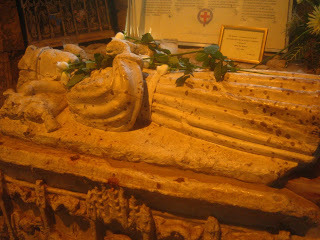
Other interesting sites in the church are the effigy of Sir Edward Thweng who died at Stirling in 1344, a carved face of a coroneted head thought to be symbolic of a Neville chantry and a beautiful stained glass 'sunne in splendour' - badge of the Plantagenets. We also manned the TBS stall for the afternoon - a few more pennies in the coffers!
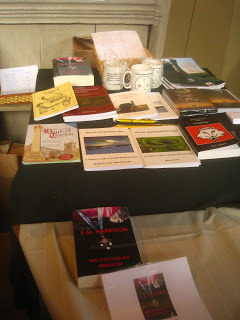 The church is open every day and tea and coffee are available - what more can you want? Sheriff Hutton castle is on private land but there is a circular walk that spans the perimeter - best when the leaves are gone from the trees.
The church is open every day and tea and coffee are available - what more can you want? Sheriff Hutton castle is on private land but there is a circular walk that spans the perimeter - best when the leaves are gone from the trees.
 Sheriff Hutton had been a Neville castle used as a stopover by Warwick amongst others when on his way to York. After Warwick's death at the Battle of Barnet in 1471 Richard was given his northern estates by Royal Decree.This was welcomed by the locals as it prevented them from receiving any punishment for supporting Warwick's treason vs Edward IV. Approximately 20 years later Sheriff Hutton was estimated to be worth ~£600 per annum in income which is pretty sizeable (Middleham at the same time was estimated to be worth ~£900 pa), so no doubt Richard was pleased with the acquisition too.
Sheriff Hutton had been a Neville castle used as a stopover by Warwick amongst others when on his way to York. After Warwick's death at the Battle of Barnet in 1471 Richard was given his northern estates by Royal Decree.This was welcomed by the locals as it prevented them from receiving any punishment for supporting Warwick's treason vs Edward IV. Approximately 20 years later Sheriff Hutton was estimated to be worth ~£600 per annum in income which is pretty sizeable (Middleham at the same time was estimated to be worth ~£900 pa), so no doubt Richard was pleased with the acquisition too.  The church guide identifies one of the alabaster tombs as being that of Richard's son, the Prince of Wales known as Edward of Middleham, but this is by no means certain and it may well have been that of a child of the Neville family, but the tomb must have been very fine at its time of construction.
The church guide identifies one of the alabaster tombs as being that of Richard's son, the Prince of Wales known as Edward of Middleham, but this is by no means certain and it may well have been that of a child of the Neville family, but the tomb must have been very fine at its time of construction.
Other interesting sites in the church are the effigy of Sir Edward Thweng who died at Stirling in 1344, a carved face of a coroneted head thought to be symbolic of a Neville chantry and a beautiful stained glass 'sunne in splendour' - badge of the Plantagenets. We also manned the TBS stall for the afternoon - a few more pennies in the coffers!
 The church is open every day and tea and coffee are available - what more can you want? Sheriff Hutton castle is on private land but there is a circular walk that spans the perimeter - best when the leaves are gone from the trees.
The church is open every day and tea and coffee are available - what more can you want? Sheriff Hutton castle is on private land but there is a circular walk that spans the perimeter - best when the leaves are gone from the trees.
Published on October 22, 2012 02:45
March 23, 2012
The Colour of Treason - Book Review
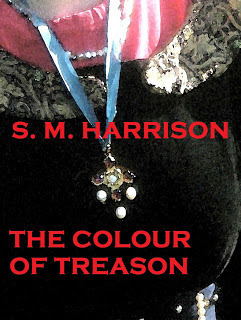 Book Review
Book Review
The Colour of Treason - S.M Harrison - Kingmaker Press 2011
This is Su Harrison’s first published novel and I excitedly knew that it was going to be a great read. I have known Su for some time as an active member of Towton Battlefield Society, re-enactor and creative writer and understood that this work was a life dream come true and I grabbed my copy and launched myself into the volume with great anticipation.
Fifty pages in and I was at a crossroads, I just couldn’t get into the story and I found myself a with a decision to take, “do I put the book down and pretend that I had read it, or do I hope for the best and keep going?” I was frustrated because I couldn’t comprehend the problem I was experiencing. The writing style was fluid, fast paced
and with reminiscent touches of the Gothic and the narrative, and crafted together in small sections which flowed with the fabric of the story. The subject matter was a labyrinth of intrigue, murder, lust, treason, greed and conspiracy which kept me turning the pages. The historic detail was beyond reproach and exquisitely researched and took you back to a time gone by. Su has been a long time student of the Wars of the Roses and passionate creative writer and I should be loving this work and the fault must be all mine.
The lead character, Elizabeth Hardacre, did not fit into my niche thinking of how a young medieval woman would behave and act in this period and these circumstances. To me she was headstrong, driven by lust, held and dropped allegiances like leaves in the wind, far too independent and too strong willed and I just didn’t like her. I explained this to a friend and was bluntly told that this was a time when England had gone mad, the age of chivalry was gone and the recognised order had been thrown upside down. This was a moment when a light was turned on, a moment when you realised that in an age where Englishmen slaughtered Englishmen, royal brothers conspired against royal brother, allegiances were formed with traditional enemies, commoners became noble and king makers became traitors that a character portraying a stereotypical English rose full of politeness, blushes and fluttering heart beats was not going to work.
When I saw Elizabeth Hardacre as a women of her times, avaricious, opportunist and determined, striving to succeed in a dangerous world which was 1470 England, I began to cherish the words and found that I just couldn’t put it down. Elizabeth Hardacre is born into a family with allegiances to both the king and Warwick the Kingmaker and she is plunged into the sea of conspiracy at a high level, as the tale ebbs and flows between Middleham, London, Calais and the maelstrom of the Battle
of Empingham. The major characters of Warwick, Clarence, Hastings and King Edward are realistically brought to life and this tale, firmly grounded with historic detail, is a pleasure to read.
I bought my copy expecting a tale of historic courtly love and intrigue championed by a damsel in distress and what I got was a tale of cold blooded treason and conspiracy from a dark time in history with a feisty character you might not like, but one you had to admire and one which made the novel work.
This work is really the crowning moment of years of research and craft, and the flawed Elizabeth Hardacre doesn’t fit the usual romantic heroine stereotype, and because of this flaw she sits perfectly alongside the other flawed gems of Warwick, Hastings, Clarence, Edward and many more in those troubled times.
Mark Taylor, Chairman Towton Battlefield Society
Towton BattlefieldSociety® Spring 2012
Published on March 23, 2012 06:56
February 22, 2012
Shop 'til you drop!
Whoo-hoo The Colour of Treason has arrived in the Towton Battlefield Society Shop! Here.
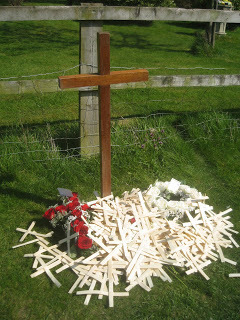 Getting ready for the Battle of Towton Commemorative event which will also include authors George Peter Algar, George Goodwin, Helen Cox and Alan Stringer - almost need an event of our own!
Getting ready for the Battle of Towton Commemorative event which will also include authors George Peter Algar, George Goodwin, Helen Cox and Alan Stringer - almost need an event of our own!
Hope to see you there!
 Getting ready for the Battle of Towton Commemorative event which will also include authors George Peter Algar, George Goodwin, Helen Cox and Alan Stringer - almost need an event of our own!
Getting ready for the Battle of Towton Commemorative event which will also include authors George Peter Algar, George Goodwin, Helen Cox and Alan Stringer - almost need an event of our own!Hope to see you there!
Published on February 22, 2012 12:38
January 30, 2012
TOWTON 2012 - A DATE FOR YOUR DIARY
Published on January 30, 2012 00:54

